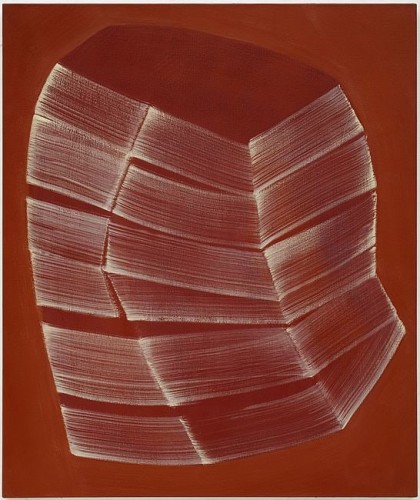
Cha cha cha, 2013, tempera on linen, 67 3/4 x 56 2/3 inches (172 x 144 cm)
Painter Robert Zandvliet on Dropping Art History for the Simplicity of Stones
By Alexander Forbes
May 16, 2013
In his latest exhibition at Frankfurt’s Berhard Knaus Fine Art, “Seven Stones,” Dutch painterRobert Zandvliet has hit the reset button on his formerly art historically oriented practice in exchange for minerals. A single stone is featured in each of the seven paintings and eight watercolors on view through the end of August, with each work oscillating between pure figuration, geometric abstraction, and color field painting. Zandvliet spoke with BLOUIN ARTINFO before the opening about the new works and making art without pretense.
These new works are fairly different than your previous series. What led you to begin painting stones?
It was a reaction to those previous works that I made over last four years. Those were referencing art history, where I used other paintings as a starting point for my own work. The show I had with those works was really nice, but also very intellectual. But after, I wanted to get to a simpler idea and simple subjects. In the early days of my practice I made paintings of everyday objects: a hairpin, a piece of chocolate, or something like that. There had been one painting in the last show that was a stone, based off of a work by Georgia O’Keeffe, which then came back to me as a way of getting back to that earlier practice. I didn’t want to paint manmade objects anymore but natural objects. A stone is what it is.
Was it a way of resetting your practice or pulling back some of the layers that you had accumulated over time?
In a way, I came back to what’s important for me, asking what painting means. It’s just a stone on a background. It seems very simple, but it’s very hard to get it right. It’s not about figuration or abstraction. It’s about the idea of the stone. It can have different colors or shapes, but the paintings are meant to have the same intention as a stone: to be absolute objects. Even though I know that there is no absolute truth, I’m searching for some essential or basic element.
How do you differentiate between the watercolors and the paintings?
The watercolors are more experimental in a way. It comes from my process of crunching up the paper before I paint on it. I get all these kind of structures from the folds. I begin to paint over it and slowly a form or a stone emerges. I’ll make five or ten of them in a day, most of which are terrible and ugly, and I have to throw them away, but one or two become something. They’re much more spontaneous than the painting because when painting I have to have a much more definite goal or full idea in mind before I can start it. There are certain rules I follow but you never really know what is going to happen. For example, now I have the idea to try and paint the same stone something like 10 times to see even when I’m thinking of the same object how the technique or even the time in which they’re produced can make the paintings look different.
Alexander Forbes